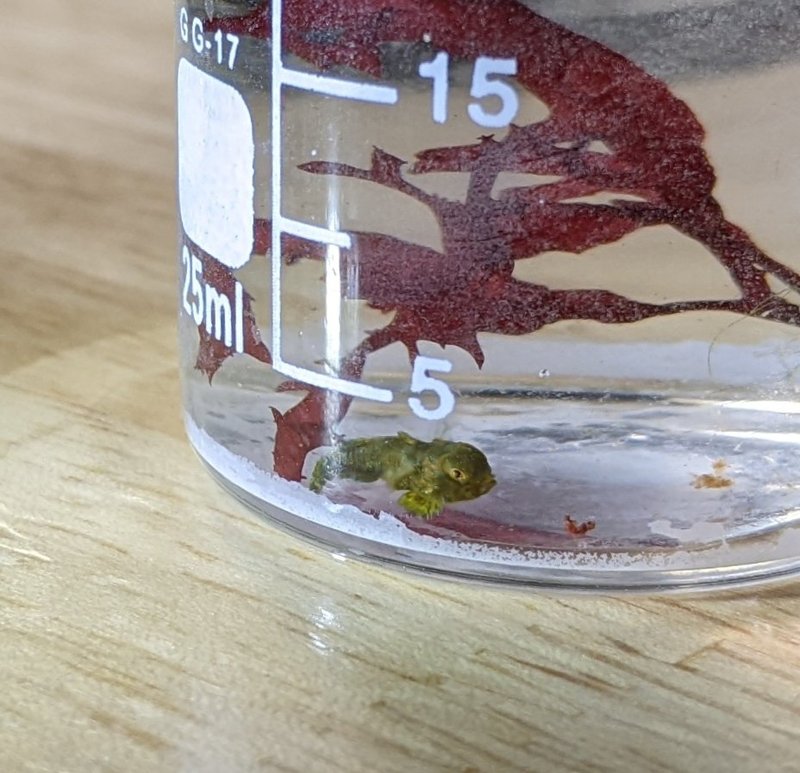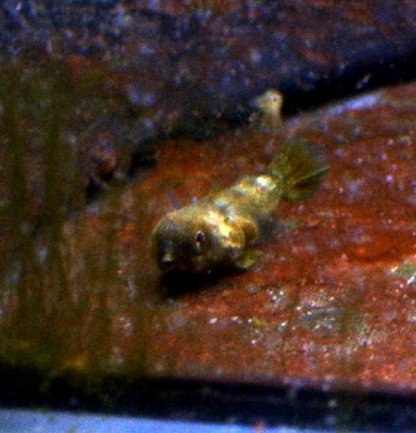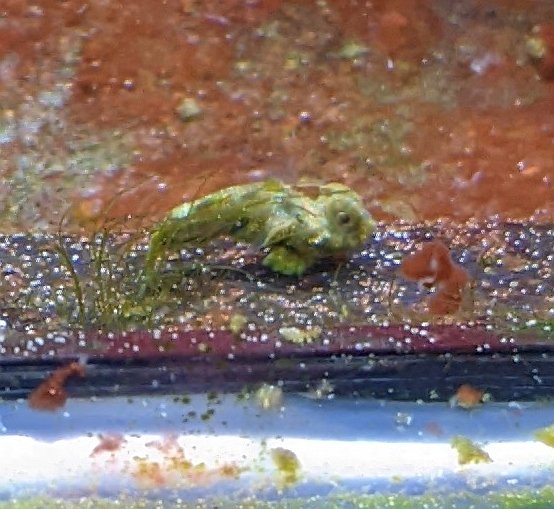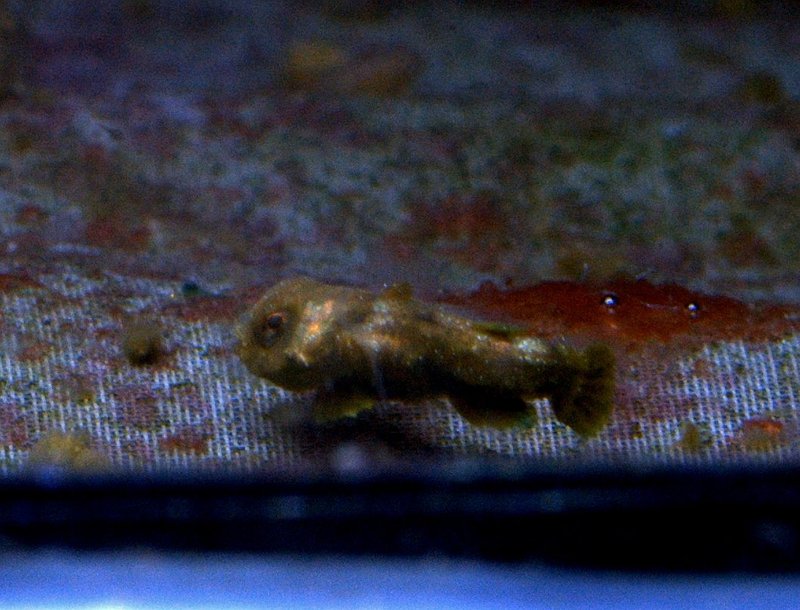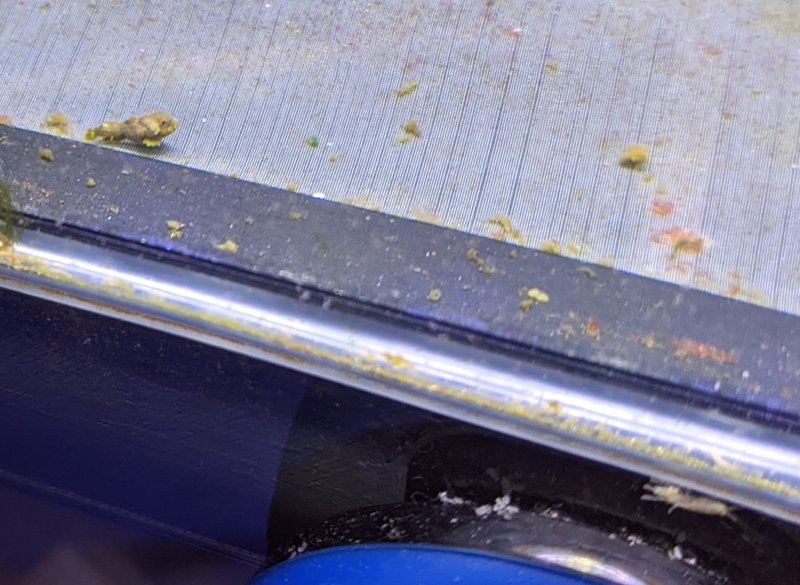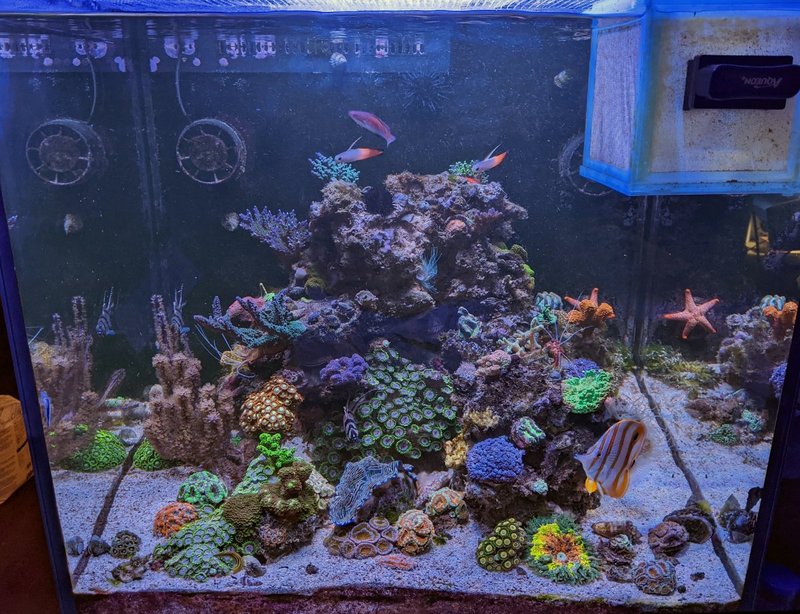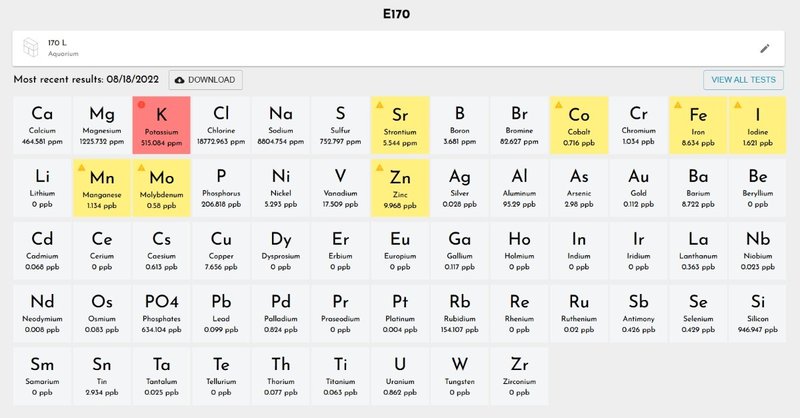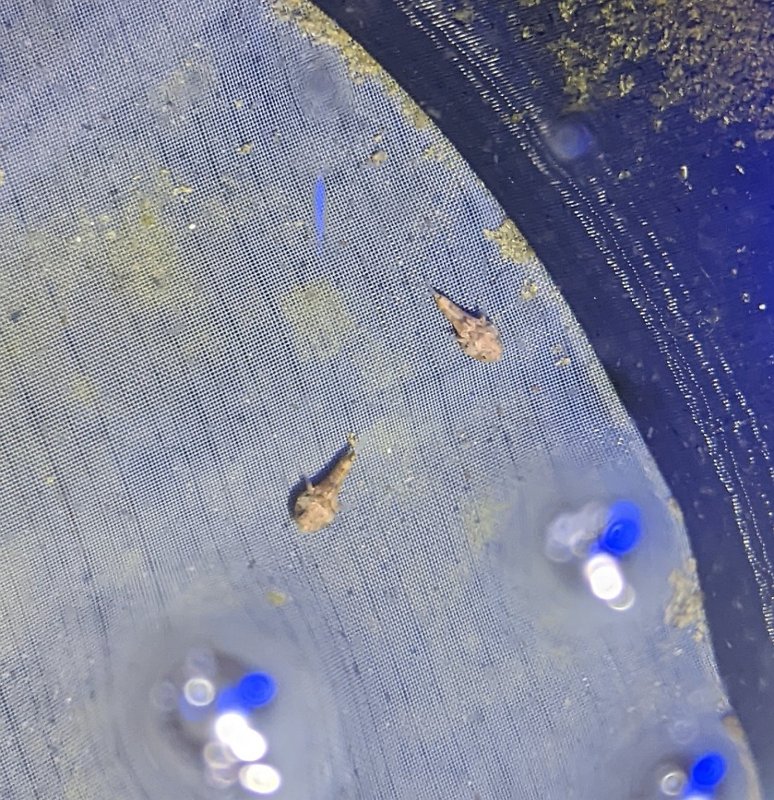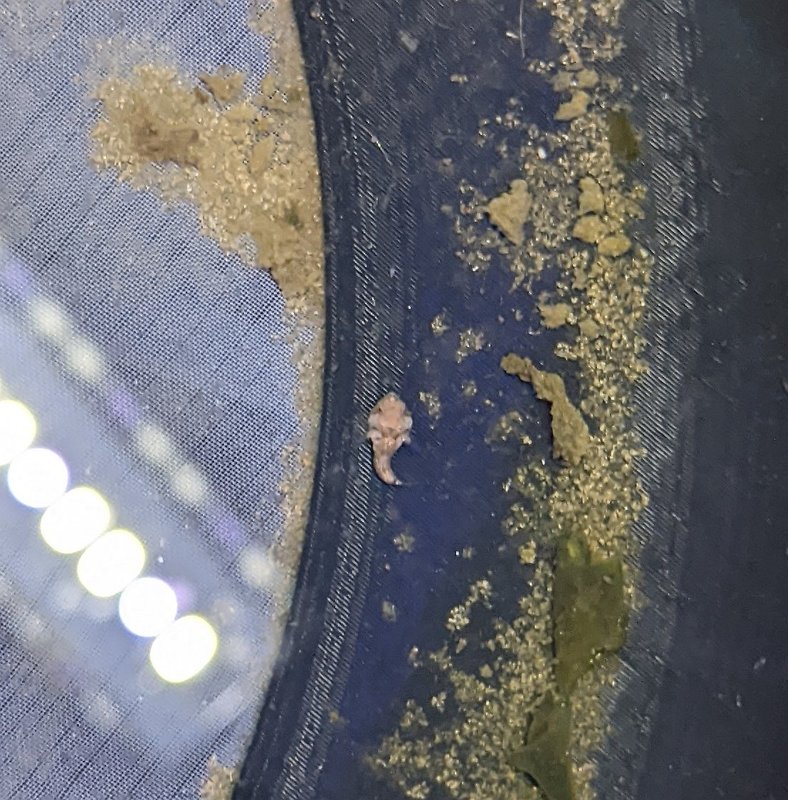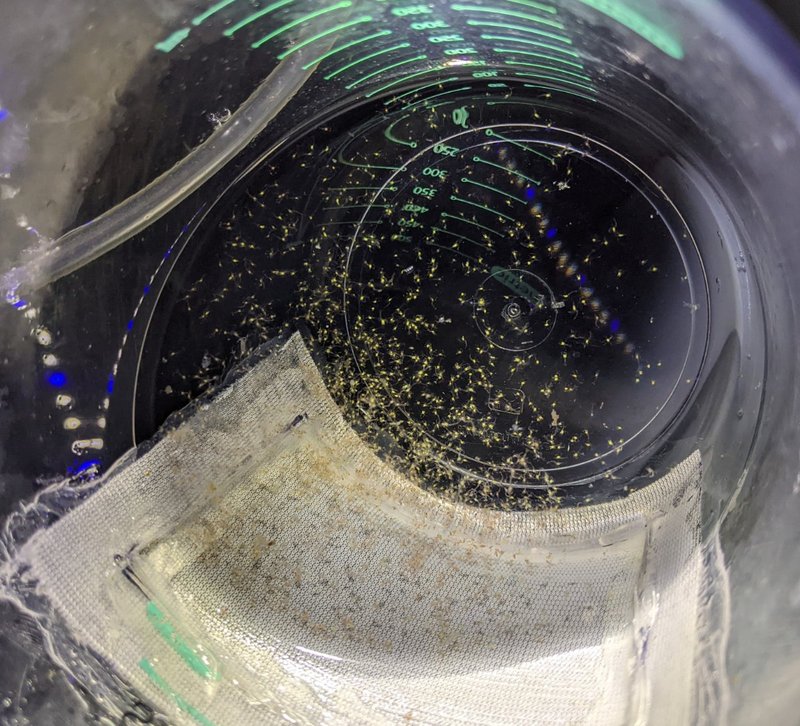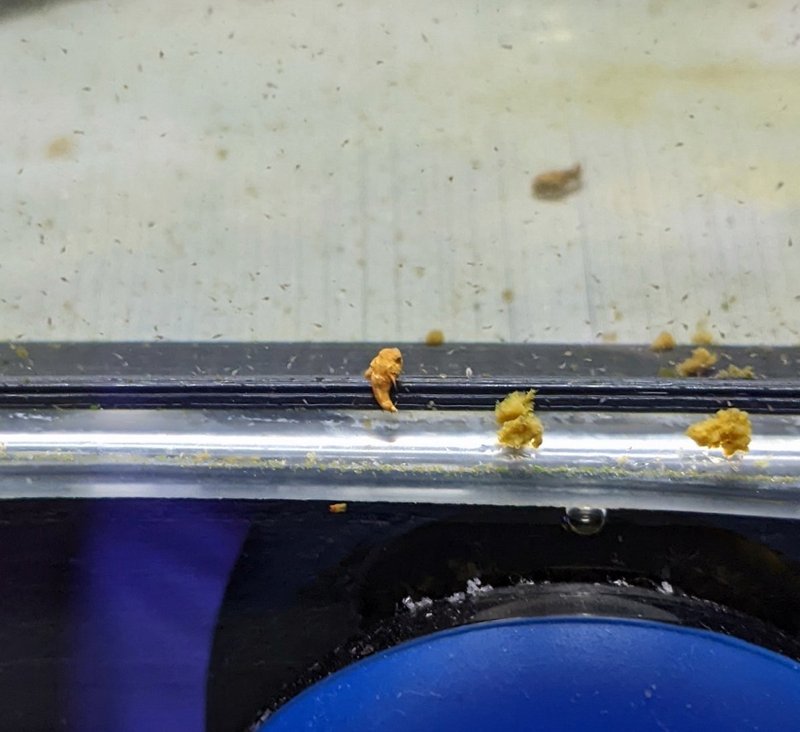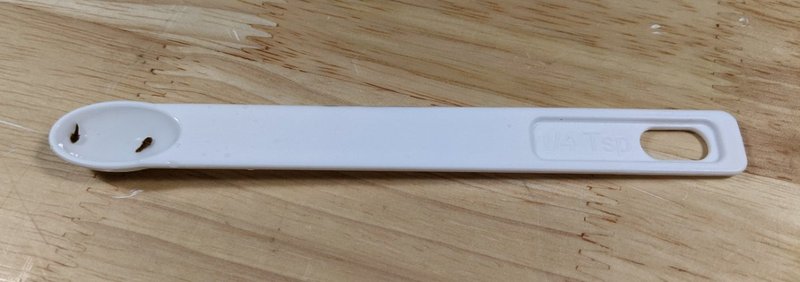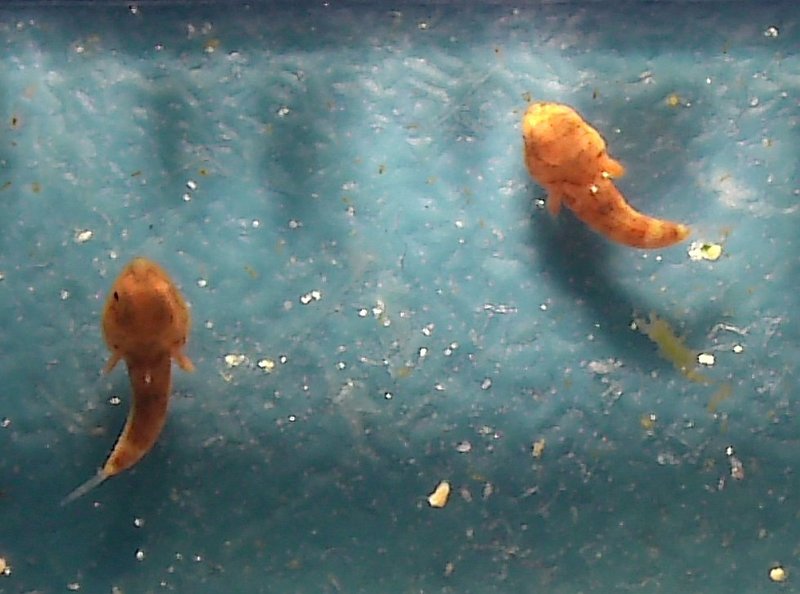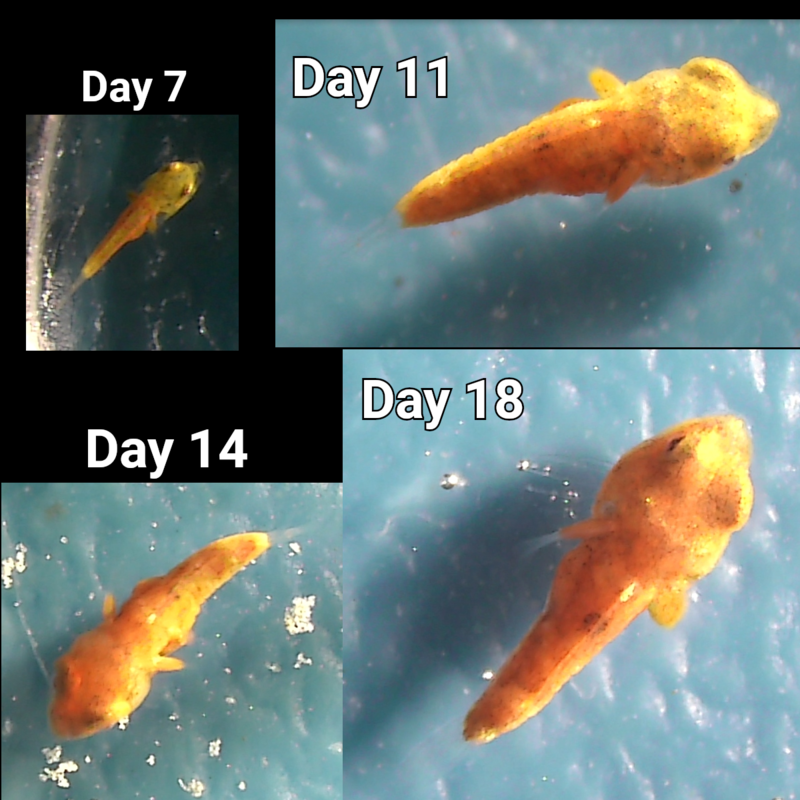-
Posts
748 -
Joined
-
Last visited
Content Type
Profiles
Forums
Gallery
Events
Store
Everything posted by DaJMasta
-
It's somewhat irregular on my tanks, ends up almost entirely being related to weather conditions that let the air system sit off for a long time, but the daily fluctuations are much smaller. I'm below 0.5C variation on an average day, but it's not uncommon to have 1C variation a few days a month.
-
It's possible it could survive if the tank is large enough and/or the remaining parent is the opposite sex, but I wouldn't try to move it to the display until it's, at minimum, an inch and a half long, which probably is 6-10 months of growth. Otherwise I don't think you'd find too much trouble rehoming it, especially for people with smaller tanks or with concerns about them being aggressive to each other, one is an appealing quantity.
-
Well they certainly have those little filaments, but I don't know if I'm any closer to being sure, haha. I wonder if that central larger thing with the filaments is a foram and the others are something else or maybe developing offspring for it. There isn't any chance that they come off of the glass, do they? I'm not so far away and could take a look under a microscope to try and get some even more zoomed in images if you were curious, but I wonder if they would even come off intact. Maybe a more elaborate way could be to magnet a few glass microscope slides to the side of the tank where they like to grow and wait for some to take hold.
-
An unusual update after a bit: My pair have spawned continuously since the last post, every month or so, and I haven't gotten a single fry out of it. I'm not really sure what's been happening, but the most recent run may be shedding some light on it. In the couple before now, I had noticed that it seemed like I was catching him later than I should, even though I was catching around day 20 or so which has been ok before, so I caught him on day 18 this time (yesterday), and before I did I thought I saw a baby in his mouth. I noticed he was wary of being in the trap when I was close to it (same method/placement as previous tries), so I rigged some fishing line and closed it from a distance. Worked fine, transferred into a mesh box in the evening, and before I went to sleep.... his cheeks and jaw were no longer puffed out, though there was no real sign of debris in the box. In the morning, same story, with a small amount of brown debris (maybe egg sack residual), and he was willing to eat, so I let him out. I think he's eating the eggs, maybe in response to being caught/moved, even though it's not long term and he doesn't actually get taken out of the water for the transfer. If this is the case, it may be pretty tricky to get more fry... there are a lot of other mouths and the typical time to spit them all out is early in the morning (when I'm not typically up), and turning off some of the circulation pumps the night before would mean pretty reduced flow until I could turn them back on. I think my plan for the next time is to catch him around day 15 and keep him in the box as before. If the eggs disappear the next day, it will be clear that he's eating them, but the hope is that maybe as they're less developed he won't feel the immediate need to and will be able to settle into the box a bit better (hopefully?). I could also try transferring him to a different tank, but unless the size/exposure of the mesh box is the thing bothering him and not the physical transfer, I'd expect it to have no effect. I've also got PE Calanus back in the frozen food rotation, in case something about my feeding was nutritionally inadequate, but I doubt it was - I've always fed heavily and with several kinds of food they like.
-
Decided I would clean the container (first time since he went into the tank), just cleaning the glass and replacing it with a new one, really. So I caught him and got a better pic: By eye, he doesn't look this green, but I think it is probably the right color up close.
-
Not much to report another week in, a little more activity around the holding tank and a little more color - some green appearing on the tips of the fins, mostly. He's probably a tad bigger, but honestly it's hard to tell, and still hard to photograph with a cell phone. The changes are happening, it's just slow... I wonder when the adult coloration will set in. I had sort of expected that by 70 days it would already look blue.
-
I got a big chunk of that bushy acro fragged in the demo (was that the pac man?) and a branch of another acro that probably started out red but which has been brown the whole time for me. Hope it colors up into something neat, the frag sizes were certainly generous!
-
You want to buy a 1.026 calibration solution and calibrate it to that. While there is nonzero value in calibrating to zero, by calibrating to a point much closer to where it will be used, it will be much more accurate, since generally, the farther from your calibration point(s) you are measuring, the less compensated the measurement will be for whatever nonlinearities the device has. It's also easy for a refractometer to drift - I found mine drifted up a couple of ppt in something like 9 months even when handled gently - so it's worth rechecking for sure.
-
How's your salinity? If there's more salt in the water (over 1.026 sg or 35ppt), you'll end up with higher numbers across the board. Could be that you've just got a bit more salt than normal. Which IO salt, though? I wouldn't expect the regular stuff to be able to reach those levels, really, though maybe reef crystals could?
-
His head has gradually widened over the last few weeks, I think the back half hasn't fully caught up, but they are certainly goofy looking fish! I think a lot of what makes him look more like an adult to me is just that the fins have coloration, but the ones behind the 'ears' that they flutter to swim still only have color at the base, and it may look more filled out behind the head when they are no longer clear.
-
Another week, another update, now with a bit of video and microscope (Aven Cyclops) footage! I'm going to just copy-paste what I just wrote for the youtube video because it's basically the whole update since last time: This little guy has passed two months old and he's still looking and acting more and more like an adult. He's got the first hint of blue/green on his anal fin and the adult patterning is clearly visible (under a microscope) in red slightly under his yellow skin, whereas there's just a little bit of metallic striping on his forehead under lower magnification. He's up to almost 1cm long mouth to tail and is much more wary of the changing environment - 10 minutes under the microscope and he was just starting to be comfortable enough to start exploring, whereas it took 30 seconds or so the last time I had a close look. Lots of looking around and taking it all in, too. In the tank, there's the usual scooting and then swimming back down because of the current, but I've seen him in the water column more frequently and on the sides (especially near the top) much more frequently. Oh, and additionally: the little scoop used to corral him into the beaker is the same one I took the picture of both in about a month ago, and the video in the tank is now on a lens with half the focal length, the size difference is pronounced and perhaps even speeding up.
-
It works pretty well, too! Not suited for aiptasia under overhangs, but anything facing up or in a crevice can be covered up pretty easily, and it's easy to apply with the included syringe. I've heard from a number of people that it's one of the more reliable methods, though I haven't tried many other products to say for myself. I have found that it's easy to miss aiptasia, so having a backup/cleanup option (or something that will eat them) as a follow up is probably not a bad idea.
-
He's still going, and is now 8 weeks old. A little bigger, than before, pretty active, full coloration on the tail fin, and still has the odd propensity to float slightly, then swims down to the surface. It happens enough that it may not just be currents in the holding container, but he seems to have a full body and stays active, so I don't think it's negatively effecting his health. A little easier to get the phone camera to focus on him now, and while I've gotten some video of him in the last two weeks which really shows the striping starting under the skin, the float and then dart down behavior and staying away from the glass a bit more than before make it harder to get something consistent. Spawning in the tank has decreased, but the cleaner shrimp are fairly regular, and I see some porcelain crab larvae every now and then. Have even caught some tubastrea larvae, I think, but that's asexual reproduction, so not quite the same. The old microscope was an Amscope T690C, and the new one is a Zeiss Axioplan 2 imaging (which was a high end research microscope about 20 years ago, not cheap), I'm still getting it all dialed in, but I've got it kitted out the way I think I want it and have some practice using most of the features/modes. The larva collector was from BRS (though manufactured by Vossen), but honestly I don't bother with it now. It works fine for what it is, and the light on a suction cup is useful (though dim, you really need all external lights off for it to count), but with a sieve built out of a measuring cup, a turkey baster, a cup, and a flashlight - you can collect everything manually pretty well once you get a spawn. Probably is slightly more efficient at capturing more, and you don't have to balance the input flow between suction and swirling action to keep the larvae safe. Oh and the microscope used for top down video a bit zoomed out of the little guys is often an Aven Cyclops, not a conventional looking one but basically a camera on an arm, but a snappy video inspection scope to work under. I can't say the camera or optics quality is amazing, but it's practical and does a pretty good job.
-
Do they definitely hatch and go away on their own? If not, maybe foraminifera? Usually they have some sort of geometric element to them, but it would likely be visible with a magnifier without having to go to a full microscope. In any case, a magnifying lens of some sort may be helpful in figuring it out. They sort of look like reddish flatworms I've had on algae before, but of course while some can be round, they move around and usually don't look round, so I really doubt it's something like that.
-
They look like nerite snail eggs, I've seen some like that on my tanks, though I don't remember seeing them on the rocks, basically just on the glass. Possibly collonista snails? I know nerites can't actually reproduce in only saltwater, but I don't know if the egg sacs can still hatch, maybe that's a point in the collonista direction. Maybe some combination with something else, like spiorbid worms?
-
Another week and the chubby little guy is still going strong. Some slight darkening of coloration and slight growth/shape change, but he's still small and yellow (appearing more brown by eye), basically. I got some video where you can see slight iridescence from the adult patterning under there, but the surface skin isn't to that color yet - maybe this coming week. Probably the biggest change from the week before is that several times I've walked up to the tank and he's sort of backed off and swam away, more like the adults would. I think either his vision is better or he's paying more attention to farther away surroundings now, so I get a little bit of a reaction when I check on him. Otherwise, there seems to be a slight amount of vertical flow in the holding tank, as he will commonly be slightly drifting up, only to then swim down and go back to browsing for food (which is literally all around), but I don't see the drifting on the solid bottom surfaces of the container, so I don't think it's like a bubble or something. Here he is today, with a medium amphipod lower right for scale:
-
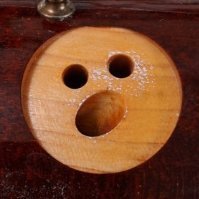
DaJMasta's 45G AIO Cube Mixed Reef
DaJMasta replied to DaJMasta's topic in Dedicated Tank (Build) Forum
Lots of changes and things, there's always something, so rather than trying to pack more and more into an update, I'll just run through some of the highlights since last time. First off, an evening FTS, things are closing up a bit, but a bit more fluorescence than the normal daytime lighting: And the obvious addition in the lower right: a big copperband. I actually bought him online and knew he was too big for the tank as soon as I opened the bag, but I figured I could house him, make sure he was eating well, and then find a home for him elsewhere. He's been an interesting fish - kind of quick to hide but definitely knows me now (and I think different color shirts made him take longer to recognize me), makes the firefish jump quite a bit more often (so far the lid is really paying dividends), gets along well with the cardinals (vertical stripe gang?), and ate a good bit of stuff growing on the rocks - some fan worms (moved one big one to the other tank once I saw it), any spaghetti worms it can find, all of the aiptasia, the hidden sea cucumber that was a hitchhiker, and some of the wing oysters and other bivalves (the scallops are all alive but no longer extend their tentacles, the derasas haven't been bothered at all). But he's been in close to a month, the bit of lymphocystis that flared up after introduction is almost entirely gone, and he's eating whatever frozen I offered. On first introduction, it took about a day and a half for him to start grazing on the rocks, then the first frozen food he took interest in was frozen hikari blood worms, with mysis and the other stuff around a week or week and a half later. I think a good way to get it some food early on is to turn the pumps off and put chunks of meaty foods on the rocks (reef frenzy nano in my case), so that when it grazes it runs into some. In the same shipment, I got a lawnmower blenny and a female ruby red scooter dragonet. I was worried the blenny would fight with the orange spot goby, but they leave each other alone! He's often out and munching on algae, and early on cleared up some patches on the live rock of really low growing stuff - I think he's helping reduce a little bit of algae growth on an acro frag which has been looking better since. The ruby red dragonet is another cute little fish, but she's been taking longer to train onto frozen than any of the previous dragonets (she's in the box on the top right). In about a week she was acting excited and grazing around in the box after feeding, and I was seeing blood worms in particular disappear later in the day, but she's not quite to the point that she eats as soon as it's offered and can differentiate the good stuff from just grazing. She actually managed to jump out, too, in the tiny gap between the screen top and the top of the box, and just lived in the tank a couple of days, but when I went to trap the male cardinal (who was carrying eggs and coming due), she got in and couldn't get out, so she's back in the mesh box to finish training. The cardinals spawned and carried the eggs to term again, but the male basically swallowed the egg mass around when they were due, and I saw him spit out a couple of dead ones before he was caught - still no idea why they haven't been successful in a few months, I'm going to try adding PE calanus back into the food rotation in the event it's some kind of nutritional thing. Last month, on the 18th, I took samples for ICP mass spectrometer analysis and microbiome analysis, and while the ICP was back before two weeks, the microbiome analysis took a little more than a month and arrived this past week. They came in like this: The ICP showed me my potassium kit was reading low (I figure around 50ppm) and my magnesium kit was reading high (around 100ppm), and both have been moved to correction. I had very occasionally been dosing iron before, and the ICP confirmed it was needed, so I added another capful and then because molybdenum was also low and the supplement I had didn't include it, I bought some Chaeto Gro to more completely supplement. I also added a drop of lugols iodine, as I have a couple times with all the inverts, and will probably do that once or twice a month (probably a similar schedule to add a capful of Chaeto Gro). Oddly, shortly after the first iron supplement with the old brand, I lost a stylo frag and the anacropora like a day or two after. I remember losing a millepora a day or two after dosing a single capful of the stuff before (about half a bottle recommended weekly dosage), so I wonder if my tank responds oddly to that mix or there is something up with the bottle itself. Didn't see any reaction from the Chaeto Gro, but maybe all that was effected was taken out the time before. The microbiome test was an interesting one, apparently high percentile microbe balance and reasonable diversity score. Maybe most baffling, no traces of cyanobacteria and no mention of dinoflagellates, though I do see both in small quantities (I remove dinos into a fine mesh net with a turkey baster maybe 1.5 times a week). I've also gotten a bunch of ulva growth in the display (easy to pick off, but persistent and not too many things eat it), and the algae scrubber grows it very well (but not hair algae, at the moment). I also have to clean the glass every other day, by the third day there is a fair amount of green on it, and am dosing Phosphate Rx every couple weeks (10 drops or so), to keep the phosphate somewhat down (below 1ppm, it's always been high). Otherwise a lot of good growth on things, a few of the little frags that only seemed to be holding on have started to color up and encrust, and those purple center green rim zoas are really going nuts, I think I need to get a scalpel and cut off some near a porites and montipora frag which are sort of being climbed even when alive. As mentioned in the mandarin breeding thread, Manny, the male, was lost after a few weeks of some unknown disease with escalating treatment attempts (H2O2, Ruby Rally Pro, formalin), but for the most part they all seem to be getting along and staying healthy. Spawns are slightly lower in frequency overall, but this could be that some of the CUC and hitchhiker inverts have died since the initial introduction, and the cleaner shrimp seem to be pretty constantly spawning. I've got several peppermints in here too (and no impact on aiptasia with just them), but I haven't yet seen spawn from them. Could be that they release the larvae at a different time of night. -
Another week, another update! While there is good and progress, this last week has been mostly sad for this project. I lost one of the two babies a couple days ago. It had been smaller for a bit and less active in the last few days before, and I couldn't tell you what went wrong or why, but it passed away. What's worse, earlier in the week I lost their father. He had been sick for 3-4 weeks with something that manifested as some lighter color/lack of color on his back (like he was sleeping, but during the day) which gradually got larger and made him overall somewhat lethargic (didn't stop the spawning, though). I tried a H2O2 dip a couple of times, then stepped it up to a Ruby Rally Pro dip, and then finally tried a full on formalin dip over the course of those weeks, and after each time he didn't look better but acted somewhat more active. In the formalin dip, he acted fine in the dip and after, but he died in the morning of the next day, basically looks unchanged. Not sure what it was (I thought maybe brook, but that should have responded to all of the medications), and I don't really expect it was just old age, though I don't know how old he was, but it was a sad day and likely puts the next run of eggs at least 3-6 months out, longer if it takes as long for them to start spawning as this pair did. In any case, there's also good. The last remaining baby is active, growing, and is showing the slightest hints of the adult coloration on its forehead. The fins are also starting to gain pigmentation (turning yellow instead of clear), and I think it's a week or two out from full adult coloration. So 6 weeks (42 days) post hatch, my remaining baby looks like this:
-
Another week and the two little ones are going strong. They have a little wider heads, a little bigger bellies, and a little more developed look to them still (maybe slightly darker patterning?). Probably the most noticeable difference is that they have mandarin eyes! The red iris has shown up about half way through the week. While these pictures don't make it easy to see, I'm definitely seeing a little of the normal color loss at night that gets darker during the day. Between the color balance and lighting conditions, these don't show it well, but the picture of both of them was taken at night and the picture of just one was taken during the day. And a video where one of the little guys does a slow rotation and shows off his fins.
-
They tend to be fairly cryptic, but they do come out in the evening - especially if the pumps are off or low. I think the simplest way, though, would be to drop in a trap near where they hang out that's baited.
-
After the seemingly successful setup of the mandarins, I bought a second 10 gallon brute trashcan and a few low power heaters and filled it up. A couple days ago was the full moon cycle of the lights, and tonight, I got a spawn of a skunk cleaner, then about 20-30 mins later, a spawn of a fire cleaner, so they will be by next run attempt! Easily hundreds of each, so the density in the trashcan seems pretty high. The plan is not to screen for copepod size and to focus on apocyclops with a small amount of tigriopus and tisbe added (the species I have available) and regular phytoplankton feedings, more to keep the copepods multiplying and nutritious than for anything to do with the larvae. I have a single long light over the two trashcans now and I already see them gathering somewhat under it, while it may not be a problem, I may try moving the light higher to try to keep them from being disoriented (more uniform lighting, more of the light coming from a similar angle, etc.) Let's see if simply moving to a big, sterile start container is the key to these guys too.
-
The little buddies are four weeks old today! Still tiny: Today I moved them out of their rearing vessel and into one of my 3d printed holding containers with a mesh bottom, full of copepods, but part of the breeder rack instead of in a separate system. I don't know if the change in lighting/depth/configuration will confuse them or complicate things, but they'll be easier to check in on and it frees up the vessel for another run of something. At some point I want to start trying prepared foods, probably still when in this container, but the increased tank volume and established filter should help maintain water quality when that happens. As for method, around settling time (day 18 or so) started added Tisbe pods, and in the last few days I've stopped adding apocyclops and added Tisbe and Tigriopus pods once daily - two benthic species instead of the pelagic ones the larvae were raised on. I'm no longer straining them for size, and that started around the same time. Keeping salinity down in the rearing vessel has been important, but not too difficult, with the regular addition of salt water from copepods and phytoplankton, and they're still plenty small to move with a turkey baster. In terms of development, in this video, and under the microscope, you can see the little swimming fins behind their gills flapping like an adult would, and you can even see a single ray of the dorsal fin on both (looks like a tiny stick) Their faces look like little puffer fish!
-
21 days post hatch, 21.5 days post spawn, the two babies have settled! One settled two days ago, but will occasionally swim around, the other was primarily free swimming and started hovering/sitting on the bottom last night, but both are scooting around today as one would expect from a mandarin. They've got a lot of growth ahead of them, and they are still very small, but I think the next milestone will likely be when I transfer them to a proper tank and out of the rearing vessel (trash can), probably to a mesh box before releasing in the tank properly (so they are big enough to get away from hydroids and amphipods and things) - they are still smaller than a full grown amphipod, maybe 4-5mm in length. Here's the two of them last night:
-
No proper settlement, but they're prowling the sides more often. They also appear slightly brownish now (first they were yellow, then reddish), though up close it's not hugely different. You can tell their head is slowly widening and more closely resembles an adult. Their fins look more developed, they're again seeming more coordinated, and the base of the new fins are starting to get a bit of color. I put together a little comparison (not size or color matched...) of their development since day 7.
-
They can be contaminated together if it gets into the pump, but the positive pressure of the air should prevent cross contamination from one culture to another. I actually ran into the former with my current setup, I had a cloth baffle near the inlet that with time and humidity grew some kind of mold and started infecting cultures (though not really all at once), but when I tracked it down, a bit of isopropyl alcohol was all that was really needed to clean it up again. You can also get inline filters to keep contaminants out, and while it certainly helps, they have to be changed regularly and tend to be a few bucks each - not worth it in my setup so far.



